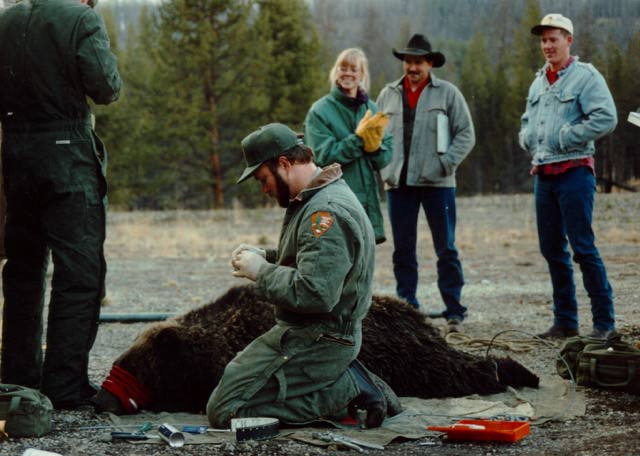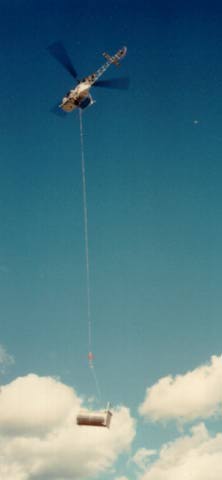



Grrrrrreetings Grizzly Fans!!
 Since our last update, there has been a full spring's worth of grizzly
activity at Yellowstone, and experts Kerry Gunther and Mark Biel have sent
in plenty of interesting information and great photographs!
We send our special thanks to Kerry and Mark for all the
information they have provided throughout the season, and especially for
the information for this update which includes their summary of grizzly
sightings, their signs of spring comments, and their answers to specific
questions about hibernation and predation on elk calves.
Since our last update, there has been a full spring's worth of grizzly
activity at Yellowstone, and experts Kerry Gunther and Mark Biel have sent
in plenty of interesting information and great photographs!
We send our special thanks to Kerry and Mark for all the
information they have provided throughout the season, and especially for
the information for this update which includes their summary of grizzly
sightings, their signs of spring comments, and their answers to specific
questions about hibernation and predation on elk calves.
Summary Of Springtime Grizzly Sightings
Kerry and Mark worked hard to keep track of the grizzly sightings during
the spring, and have provided us with the following summary:
 To: Journey North
To: Journey North
From: Kerry Gunther and Mark Biel,
Yellowstone National Park
Here are the sightings we have so far, arranged by date for easy sorting.
2/16/96 - Grizzly Sighting - Rabbit Creek North of Old Faithful
2/21/96 - Grizzly Tracks - Washburn Hot Springs Thermal Area
3/18/96 - Black Bear Tracks - Near Tower Falls
3/19/96 - Grizzly Sighting - North edge of Pelican Valley
3/21/96 - Grizzly Sighting - Nymph Lake North of Norris Jct.
3/21/96 - Black Bear Sighting - Rainy Lake near Tower Jct.
3/24/96 - Grizzly Sighting - Along Campanula Creek on park's West side
3/25/96 - Grizzly Bear #264 (Adult female) - North of Nymph Lake
(Radio-verified by Kerry and myself)
 3/26/96 - Black Bear Sighting - Tower Falls Area
3/26/96 - Black Bear Sighting - Tower Falls Area
3/26/96 - Grizzly Tracks - On Lamar River Trail
3/31/96 - Grizzly Tracks - About 1/2 Mile from Nez Perce wolf acclimation pen
4/1/96 - Grizzly tracks - 1/4 Mile from Nez Perce wolf acclimation pen
4/18/96- Bear-wise, things are picking up. We have had several sightings of bear #264 (an adult female) in the northern portion of the park.She has been feeding on winter-killed carcasses. There are several other radio-collared bears that are still in their dens or in the general vicinity of their dens still trying to shake the post-hibernation blahs! There have also been grizzly bear sightings around fishing bridge, in LaMar Valley, and North of Old Faithful.
As you can tell the bears are out in force now!
Signs Of Spring In Yellowstone
Mark and Kerry gave us this May 13 update on various signs of spring which
they witnessed :
"Our season is just beginning to pick up!
Signs of spring we are witnessing now include: snow melting in the park interior, rivers beginning to swell with the associated run-off, new grass beginning to grow at lower elevations (below 6500 ft) and the bison beginning to calve. The temperatures have been in the high 20's to mid 30's at night and it has been fairly warm during the days (in the 50-60 range).
Several bears have been observed in the Lamar Valley eating winter-killed ungulates, mating, and on one occasion a sow with 2-yearlings was observed killing a cow elk."
Answers To Questions
Kerry and Mark have sent in these answers to specific questions about
grizzly hibernation and their predation of elk calves.
From UTAH:
Q. "This is really trivial, but has been bugging me - on the poster and
notebook cover, it says "grizzly bears emerge from hibernation".
According to the Utah Project Wild program, bears do not hibernate! They
sleep in the winter, but can be aroused unlike hibernating animals.
Bears do not lower their body temperature and have to return to normal
temps in the spring! I have spend three years convincing the students
that bears are not technically a hibernating animal, but you have it on
the poster! Am I wrong? I'd be anxious to know if grizzlies really do
"hibernate" rather than "sleep".
Thomas D. East
A. Grizzly bears do hibernate! Years ago some scientists didnt consider bears to be "true hibernators" because unlike most hibernating mammals, bears only drop their body temperatures a few degrees (about 11 degrees to approximately 31 degrees C) during winter dormancy. Many mammals that hibernate drop their body temperatures to approximately 5 degrees C.
Today, most scientists refer to hibernating mammals that drop their body temperatures down to about 5 degrees C as"deep hibernators". Deep hibernators have to wake up periodically to eat, urinate, and defecate. Most bear biologists refer to bears as "super hibernators" because bears can hibernate the entire winter (as long as 6 months) without eating, urinating, or defecating. In addition,since bears maintain a relatively high body temperature during dormancy, they can fairly quickly wake up and defend themselves against threats.
From KANSAS:
Q. Something that I would be interested in knowing from Yellowstone is
whether the grizzly bears have starting working the Lamar Valley's elk
calves? By mid-May, there are normally some hungy bears "mixing" with the
calves.
Ken Highfill
A. As for the question from the teacher regarding the bears preying on the elk calves: Right now only the bison are calving; bears are not known to prey on bison calves. The elk begin calving in Yellowstone in mid-May. The peak in both elk calving and elk calf predation by bears occurs in mid-June in most years. So the answer is "no, not yet."
Kerry Gunther, Bear Management Specialist
Mark Biel, Bear Management Technician
United States Department of the Interior
National Park Service
Yellowstone National Park
Wyoming
This is the Final Grizzly Bear Update for the 1996 Season





 |
|
|---|